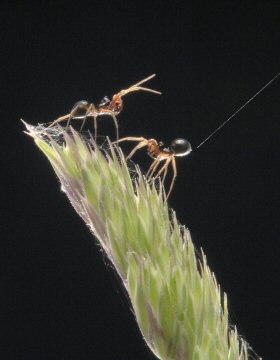
Researchers are using a new model to explain how spiders “fly” or “parachute” on their webs, a trick that lets them cover incredible distances on a single thread of silk when evading danger or re-colonizing. Improving on existing theory by adding in the effects of turbulence, the new model shows how spiders can sometimes travel hundreds of miles in a single flight.
Sponsored by the Biotechnology and Biological Sciences Research Council (BBSRC), researchers at Rothamsted Research have been able to develop a mathematical model that greatly improves upon the old Humphrey model used to gauge spider flight, or “ballooning.” For over 20 years, researchers using the Humphrey model had no way of explaining how spiders managed to miraculously colonize new volcanic islands or land on ships many hundreds of miles out to sea. “Researchers knew that spiders could use ballooning to cover long distances but no previous model has adequately explained how this worked,” says Rothamsted researcher Dr Andy Reynolds.
Colleague Dr Dave Bohan describes how both past and present models have come together to create greater understanding of the phenomenon: “To really understand the factors at play on ballooning spiders we need to watch them in action. We have already observed spiders ballooning through still air and we are now planning to take them into a wind tunnel to watch how they handle turbulent flows. Once we have done that we can refine the model further.”
According to Reynolds, the new mathematical model represents a significant contribution to agriculture and ecosystems. “Spiders are key predators of insects and can alleviate the need for farmers to spray large quantities of pesticide. But they can only perform this function in the ecosystem if they arrive at the right time. With our mathematical model we can start to examine how human activity, such as farming, affects the dispersal of spider populations.”


















Comments are closed.